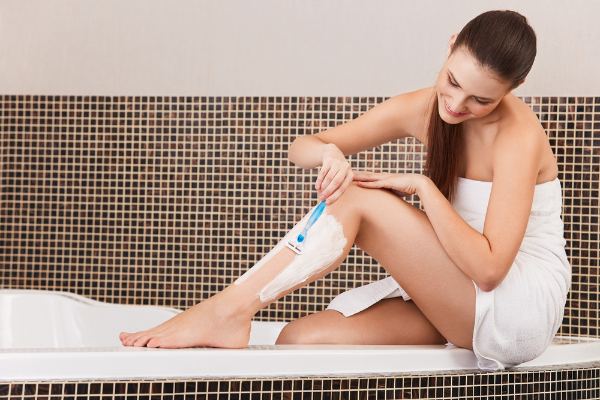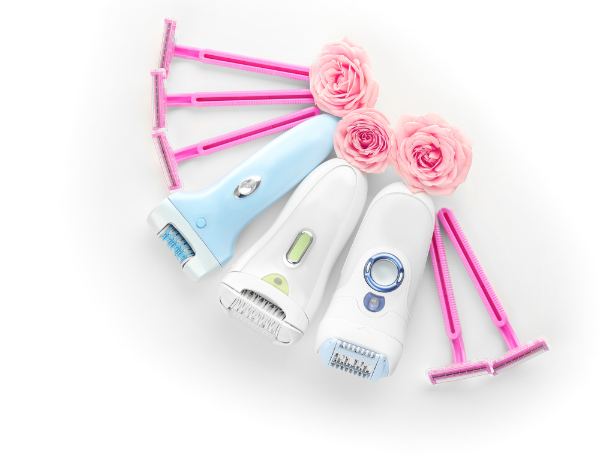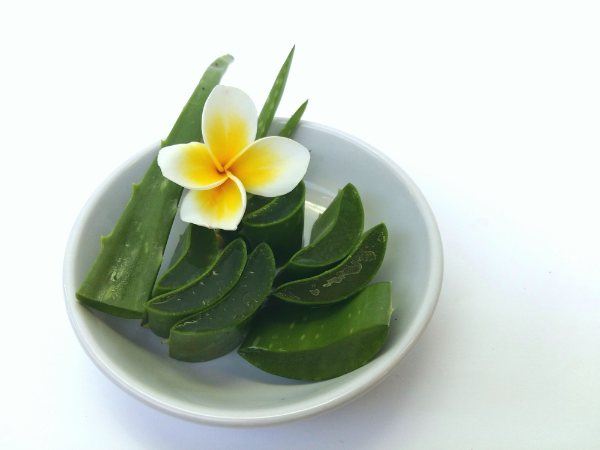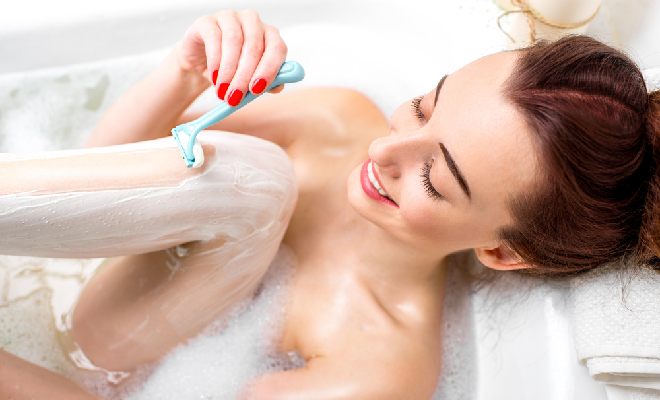Shaving is probably the easiest, most convenient, and most affordable way to remove unwanted hair. However, razor burn and bumps due to shaving are also two of the most common skincare problems.
When your skin doesn’t turn out as hair-free, smooth, and beautiful as you had wanted, and when it turns red and painful, what can you do?
Know more about what causes it and some tips on how to prevent and treat razor burn!
What Is Razor Burn?

What Is Razor Burn – Image/Shutterstock
First, let’s know what razor burn is.
Razor burn is an unsightly and uncomfortable skin condition that may occur after shaving your underarms, face, legs, bikini area, or any other body part to remove unwanted hair.
It can hurt as if the skin got burned, hence the term.
Its signs and symptoms include:
- Stinging.
- Redness.
- Tenderness.
- A hot, burning sensation.
- Itchiness.
- Swelling of the skin.
- Small red rashes.
Painful bumps on the skin may also appear, called razor bumps. Sensitive skin rash bumps result from constantly having a razor burn.
Sometimes, the hair follicles get infected or maybe the clogged pores with dirt, bacteria, and skin cells develop into pimple-like bumps or rashes on the previously shaved area.
Razor bumps, also called pseudofolliculitis barbae, are tiny abscess-filled bumps or sometimes darkened patches of skin that appear soon after shaving.
They can also form when the shaved hair grows back at an angle and pushes on the skin.
Razor bumps are most common in people with curly hair or kinky hair.
In fact, a study once showed that 83% of African-American men develop razor bumps.
Causes of Razor Burn
Improper use of a razor or using the wrong tools and products when shaving can cause the removal of some of the skin tissue along with the hair.
This can cause irritation, redness, or skin inflammation, all characteristics of razor burn.
The Causes of Razor Burn Include:
- Displacement of the skin or twisting and pulling of hair follicles due to too much pressure and scraping from your razor blade.
- Not using any shaving lubricant such as shaving cream or at least soap and water.
- Shaving against the direction of hair growth.
- Shaving with a razor that’s clogged with shaving cream, soap, or hair.
- Use of an old, rusty, and/or blunt razor.
- Running the razor blade too many times over the same area of the skin.
- Shaving too fast.
- Certain shaving lubricants and products or razors that cause skin irritation.
- Shaving a portion of the skin that’s too dry.
How to Prevent Razor Burn?

How to Prevent Razor Burn – Image/Shutterstock
Thankfully, skincare issues like razor burns and bumps can both be prevented through proper shaving techniques.
Some even believe that the best way to treat razor burn is to avoid getting it in the first place.
So, here are some useful tips on how to prevent razor burn:
- Maintain and replace your razor or its blades regularly and frequently.
- Dermatologists recommend replacing your razor or the blades after five to seven uses.
- Do not leave your razor where it is constantly wet such as in the bathroom.
- This encourages rust and bacterial buildup.
- Instead, dry it thoroughly before storing it in a cool, dry place.
- Never shave without the appropriate lubricant.
- Only shave along the same direction that your hair grows.
- Use a sharp or new razor.
- Wet your skin with warm water or even better, allow your skin to be hydrated by leaving or running some water over it for at least two minutes before shaving.
- Avoid multiple-blade razors because although they provide closer shaves, they also increase your risk of getting razor burn and red razor bumps especially if you have sensitive skin.
- Clean your skin before shaving, preferably using a gentle exfoliant scrub like you would for your daily skincare routine.
- Gently pat your skin dry instead of wiping or tugging at it after shaving.
- Apply an aftershave moisturizer, ideally, one that contains glycerin and emollients.
- Aftershave lotions with niacinamide[1] may reduce redness, moisture loss, skin inflammation rash, chapping, and other razor burn symptoms.
- These are also the products for razor burn and ingrown hair avoidance.
How to Treat Razor Burn?
The 9 Methods to Try!
But if you didn’t know about these things and already ended up with razor burns, don’t lose hope!
There are still easy and effective ways of treating razor burn and how to fix bumps from shaving such as:
1. Do Not Shave, Irritate, or Touch Razor Burned Skin.

Take Care Of Razor Burn Skin To Avoid Inflammation – Image/Shutterstock
One treatment for razor burn is not to apply anything that can irritate your freshly shaved skin such as strong deodorants or perfume.
Avoid wearing tight underwear and clothes.
To avoid needing any of such, you could just shave at night before bed.
Leaving the skin alone gives it time to heal and prevents further infection, irritation or inflammation.
2. Apply The Cold Compress
Soothe itchy skin and inflammation by applying a cool, wet compress on the affected area.
To do this, simply place a clean washcloth under cold water or dip in ice-cold water.
Wring off excess water and place on the affected skin area for up to 20 minutes.
Repeat as often as you need to.
3. Natural Astringents

Natural Astringents Can Calm Razor Burn – Image/Shutterstock
One of the most popular ways to calm razor burn at home is by using natural astringent liquids.
This helps in razor burn itching relief as well as in the reduction of redness, swelling, and inflammation associated with razor burns and bumps.
Some natural astringents include chilled brewed black tea, apple cider vinegar[2], witch hazel extract, and a few drops of tea tree oil mixed with water.
You can apply these directly or add them to a cold compress.
4. Natural Oils
Natural oils from fruits and nuts help moisturize and soften the skin.
This can help prevent ingrown hair on the skin and cure burning, itching, and tenderness.
Some common oils are avocado oil, olive oil, coconut oil, and sweet almond oil.
Dry skin can also be treated with emollients like moisturizers, aftershaves, and lotions.
Avoid products with alcohol and strong scents as these can contribute to skin irritation.
Related: 7 Effective Armpit Skin Tag Removal Treatments That Actually Works
5. Aloe Vera

Aloe Vera Helps To Overcome Razor Burn – Image/Shutterstock
A study has proved aloe vera gel to be effective in soothing razor burn and reducing inflammation.
You can apply the gel from the plant directly on the affected area or use aloe products for damaged and sensitive skin.
6. Baking Soda
Sodium bicarbonate or baking soda is known to be a natural treatment for a variety of ailments including razor burns and bumps.
Does razor burn itch and spread?
Mix a tablespoon of baking soda with a cup of water and apply it to the skin with a cotton pad.
Once dry, rinse it off to relieve symptoms. You can also put a cup of baking soda in a lukewarm bath.
7. Oatmeal Bath

Razor Burn Can Be Treated With Oatmeal Bath – Image/Shutterstock
An oatmeal bath involves adding an oatmeal-based product or regular or colloidal oatmeal to a tub of lukewarm water for relieving razor burn on the legs and pubic area.
It also has anti-inflammatory and antioxidant properties.
8. Over-The-Counter Product and Medication
You can also treat razor burn with over-the-counter lotions, baby oil, rash creams, and aftershave products to soothe irritated and razor burned skin.
9. Antibiotics

Antibiotics Can Treat Razor Burn – Image/Shutterstock
When razor burns are accompanied by razor bumps, there’s a high chance of getting an infection.
This can be seen as pus-filled whitish heads and tenderness.
If you have these, consult a doctor and ask for an antibiotic prescription.
FAQ’s:
Que: How to treat razor burn on the pubic area?
Ans: Razor burn normally goes away on its own. If a person experiences pain and itching, using a low-strength topical hydrocortisone cream may bring relief.
Que: How long does it take for razor bumps to disappear?
Ans: Razor burn usually clears up within two or three days. Self-care and home remedies can help symptoms clear even earlier.
Que: How to treat razor burn on legs?
Ans: Razor burn and razor bumps on your legs should go away with time. Moisturize the area after shaving, apply a cool compress, Try a home remedy, use a topical cream.
Conclusion
Razor burn can hurt and become bothersome. Fortunately, many ways to treat razor burn are available and easily accessible even in your own home.
Follow the tips for preventing and treating razor burn so you can be both hair-free and razor burn-free!
Like this post? There’s more. Get tons of beauty tips, tutorials, and news on the thebeautyinsiders Facebook & Twitter page. Like us on Facebook – we’ll see you there!
 By Wendy Gould
By Wendy Gould





